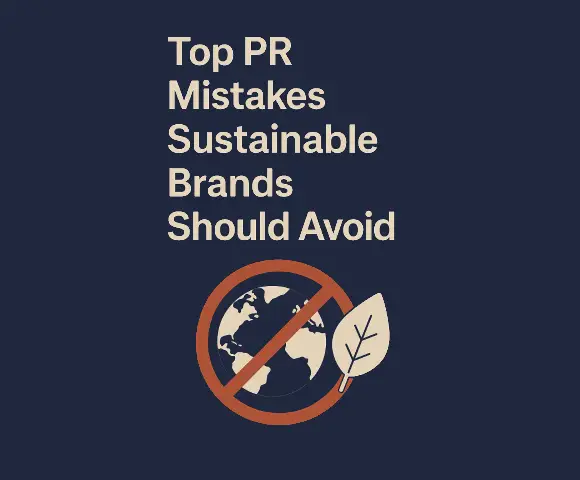The sustainability revolution has fundamentally transformed how consumers evaluate brands. Today’s eco-conscious shoppers don’t just want green products—they demand radical transparency, authentic storytelling, and measurable impact from the companies they support. This shift has created unprecedented opportunities for sustainable brands, but it has also amplified the consequences of Public Relations missteps.
Growing consumer scrutiny of green claims means that every sustainability message is under a microscope. Social media has empowered customers to fact-check environmental promises in real-time, while regulatory bodies are increasingly cracking down on misleading green marketing. In this landscape, the role of PR in shaping sustainability narratives has never been more critical—or more challenging.
At Jive PR + Digital, we’ve seen first-hand how even the most well-intentioned eco-conscious brands can fall into common PR traps that compromise their credibility.

The difference between sustainable brands that thrive and those that struggle often comes down to avoiding these costly communication mistakes. Let’s explore the seven most damaging PR pitfalls sustainable brands face and how to navigate them successfully.

Greenwashing occurs when brands overstate, exaggerate, or mislead consumers about their sustainability efforts. This can range from making vague claims like “eco-friendly” without evidence to highlighting minor green initiatives while ignoring major environmental impacts. Even well-intentioned brands can accidentally greenwash by focusing on aspirational goals rather than current realities.
Greenwashing erodes brand trust at a fundamental level. When consumers discover that sustainability claims don’t match reality, they don’t just stop buying—they actively warn others. The damage extends beyond lost sales to include regulatory scrutiny, social media backlash, and long-term reputation harm. In today’s connected world, greenwashing accusations can go viral within hours, creating crisis situations that take years to recover from.
Authenticity starts with facts. Stick to third-party certifications, measurable data, and verified achievements rather than making broad environmental claims. Highlight your progress and journey rather than positioning your brand as perfect. Consumers actually prefer brands that acknowledge their imperfections while demonstrating genuine commitment to improvement.
Instead of claiming “100% sustainable,” try “50% of our supply chain is now carbon-neutral, with plans to reach 75% by 2026.” This approach builds trust by showing concrete progress and future commitment without overpromising.
We guide our clients toward transparency-first messaging that resonates with eco-aware audiences. Our approach focuses on storytelling that celebrates authentic progress while acknowledging the ongoing journey toward sustainability. This honest communication style actually strengthens brand credibility and creates deeper connections with conscious consumers.

Many sustainable brands unknowingly send mixed sustainability messages across their various communication channels. Their website might emphasize carbon neutrality, their social media focuses on packaging innovations, their PR pitches highlight community impact, and their product packaging mentions recycled materials. While all these elements might be true, the lack of cohesive narrative creates confusion.
Inconsistent messaging confuses consumers and weakens your overall brand narrative. When sustainability messages don’t align across touchpoints, it raises questions about whether your brand truly understands its own environmental impact. This fragmentation also makes it harder for media, influencers, and customers to clearly communicate what your brand stands for, reducing word-of-mouth effectiveness.
Create alignment through strategic planning and cross-departmental collaboration. Develop a comprehensive PR content calendar that ensures sustainability messages are coordinated across all channels. Establish regular communication between PR, marketing, product development, and legal teams to maintain consistent messaging while adapting content for different platforms and audiences.
A sustainability messaging framework should anchor all communications—from media pitches to TikTok videos. This framework should include your core sustainability pillars, key proof points, and consistent language that can be adapted for different contexts while maintaining message integrity. We help brands create these frameworks to ensure every piece of content reinforces their environmental commitment.

When faced with criticism about sustainability practices, some brands choose silence or extremely slow responses. They might hope negative attention will fade naturally, or they might struggle to craft an appropriate response while controversy builds online. This
Silence in the face of criticism appears evasive and can actually fuel more negative attention. Social media algorithms often amplify controversial content, meaning that unaddressed criticism can continue spreading long after the initial incident. This approach also misses opportunities to demonstrate the transparency and accountability that conscious consumers expect from sustainable brands.
Prepare a comprehensive real-time crisis response plan specifically tailored to sustainability-related issues. This plan should include pre-approved messaging templates, clear escalation procedures, and designated spokespeople who understand both sustainability issues and your brand voice. When criticism arises, address concerns openly and share specific corrective steps you’re taking.
We’ve helped clients manage viral criticism by crafting honest, forward-looking responses that turned backlash into opportunity. One client facing criticism about supply chain practices used the moment to announce a new transparency initiative, complete with third-party auditing and public progress reports. The result was increased brand trust and positive media coverage about their commitment to accountability.

Many sustainable brands focus exclusively on their own voice when communicating about environmental initiatives. They talk about their values, their goals, and their achievements without incorporating perspectives from employees, supply chain partners, community members, or customers who are part of their sustainability journey.
This top-down approach makes brands appear disconnected from the real-world impact of their sustainability efforts. It can also seem self-serving, as if the brand is only interested in promoting itself rather than genuinely advancing environmental causes. In an era where authenticity is paramount, missing these authentic voices represents a significant missed opportunity.
Actively incorporate diverse stakeholder voices into your sustainability storytelling. Feature supply chain partners who are implementing sustainable practices, showcase employee-led environmental initiatives, and collaborate with ethical influencers and user-generated content creators who align with your values. These voices add credibility and demonstrate that your sustainability commitment extends beyond marketing.
Authenticity is amplified when the message comes from more than just the brand. We help clients identify and showcase the diverse voices that are part of their sustainability story. Whether it’s a farmer using regenerative practices in your supply chain or an employee who started a office composting program, these authentic voices create more compelling and trustworthy narratives than traditional brand messaging.

Some sustainable brands focus heavily on communicating their values and intentions without providing concrete proof of their environmental progress. They might talk about their commitment to sustainability without sharing specific metrics, achievements, or transparent reporting about their actual impact.
Today’s consumers and media expect data-backed sustainability claims. Without measurable proof, even genuine sustainability efforts can appear as empty marketing speak. This skepticism is well-founded, as the market has been flooded with vague environmental claims that lack substance. Brands that can’t demonstrate measurable impact miss opportunities to differentiate themselves from less committed competitors.
Develop robust impact measurement and reporting practices that can be translated into compelling PR content. Publish annual impact reports or regular sustainability highlights that showcase concrete achievements with specific data. Work with your PR team to transform these reports into media-friendly content formats like infographics, social media campaigns, and story pitches that make complex data accessible and engaging.
Create content that makes your impact tangible and relatable. Instead of just reporting “reduced carbon emissions by 30%,” explain what that means in terms people can understand, such as “equivalent to taking 500 cars off the road for a year.” This approach makes environmental data more meaningful and shareable.

Some sustainable brands focus exclusively on traditional earned media coverage, hoping that press mentions and media features will be sufficient to communicate their environmental message. While earned media is valuable, this singular focus ignores the power of owned and paid channels to amplify sustainability messaging.
Relying solely on earned media limits your audience reach and reduces control over your sustainability narrative. Media coverage can be unpredictable, and journalists might focus on aspects of your story that don’t align with your key messages. Additionally, earned media alone often can’t reach the diverse audiences that are interested in sustainability content, particularly younger demographics who consume information differently.
Integrate multiple channels into your sustainability communication strategy. Combine traditional PR with influencer marketing, social media content, and user-generated campaigns to create an omnichannel approach. Develop shareable, mission-led content series that can live on your owned channels while also being picked up by media and influencers.
We blend PR, social media, and influencer strategy to make sustainability campaigns truly omnichannel and memorable. Our integrated approach ensures that sustainability messages reach audiences across multiple touchpoints, from traditional media coverage to TikTok videos to influencer partnerships. This comprehensive strategy maximizes both reach and impact while maintaining message consistency.

Many sustainable brands fail to adapt their communication strategies to meet the specific expectations of Gen Z consumers, who represent a critical demographic for environmental brands. These brands might use communication approaches that worked for older generations without recognizing that Gen Z has fundamentally different expectations for how brands should discuss and demonstrate sustainability.
Gen Z consumers are particularly skeptical of traditional marketing approaches and expect action over advertising. They can quickly identify inauthentic sustainability messaging and are more likely to call out brands that don’t meet their standards. Missing this demographic means losing access to the consumers who are most likely to become long-term advocates for sustainable brands.
Build community around purpose rather than just promoting products. Co-create content with Gen Z creators who can authentically communicate your sustainability message to their peers. Focus on highlighting concrete actions like ethical trade practices, circular economy initiatives, and climate action rather than abstract environmental values.
Engage Gen Z through the platforms and formats they prefer, including TikTok, Instagram Stories, and interactive content that allows them to participate in your sustainability journey. Show behind-the-scenes content that demonstrates your actual environmental practices rather than polished marketing messages.
We help brands meet younger audiences where they are with authentic, engaging content that showcases real sustainability action. Our approach focuses on collaboration with Gen Z creators who can communicate environmental messages in ways that resonate with their peers, creating genuine connections rather than traditional advertising relationships.
The path to effective sustainability PR doesn’t have to be filled with costly mistakes. By understanding these common pitfalls and implementing strategic solutions, sustainable brands can build communication programs that genuinely reflect their environmental commitment while resonating with conscious consumers.
The future of sustainable brand PR lies in authenticity, transparency, and compelling storytelling that goes beyond traditional marketing approaches. Brands that master this balance—showing real progress while acknowledging ongoing challenges, incorporating diverse voices while maintaining consistent messaging, and reaching audiences across multiple channels with genuine content—will build the trust and advocacy that drive long-term success.
Remember that sustainability PR mistakes are entirely avoidable with the right strategic guidance and commitment to authentic communication. The brands that thrive in the sustainability space are those that choose to work with partners who understand both environmental issues and effective communication strategies.
Ready to elevate your sustainability communication? Schedule a free strategy session with Jive PR + Digital to avoid common sustainability PR pitfalls and build a communication plan that truly reflects your brand’s mission. Let’s work together to turn your environmental commitment into compelling stories that drive both impact and business results.